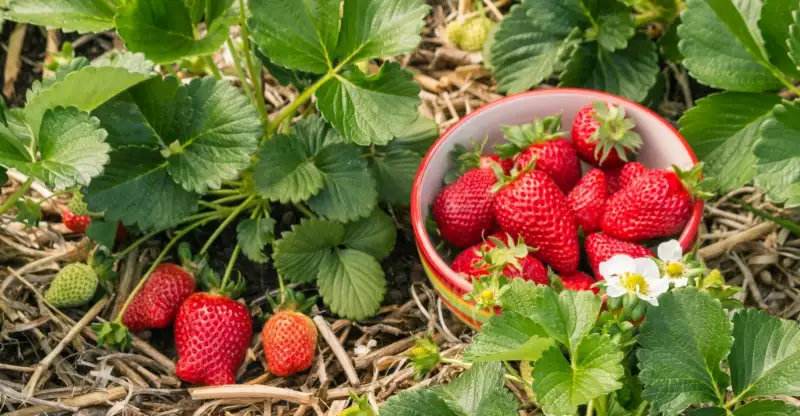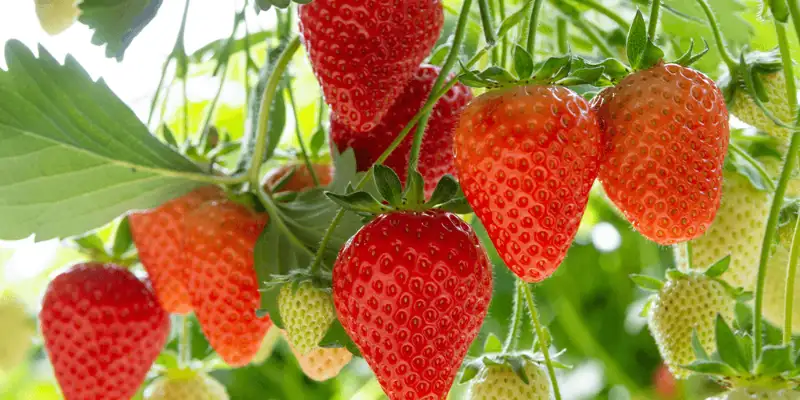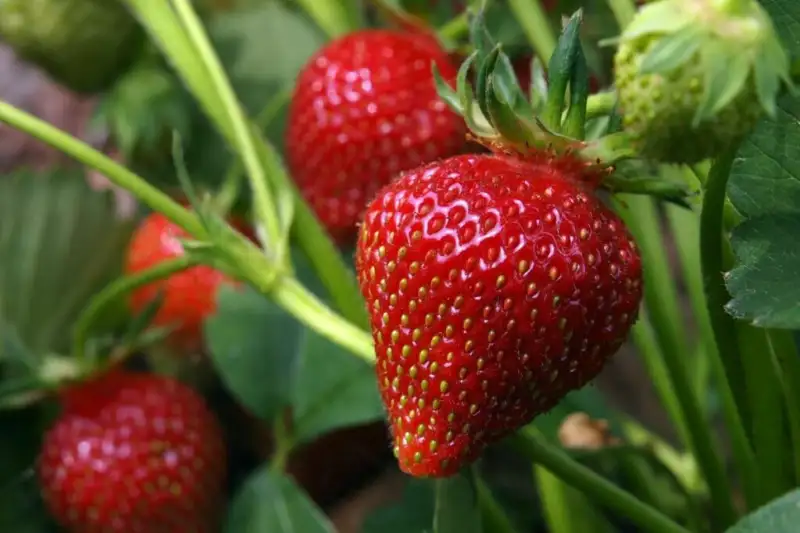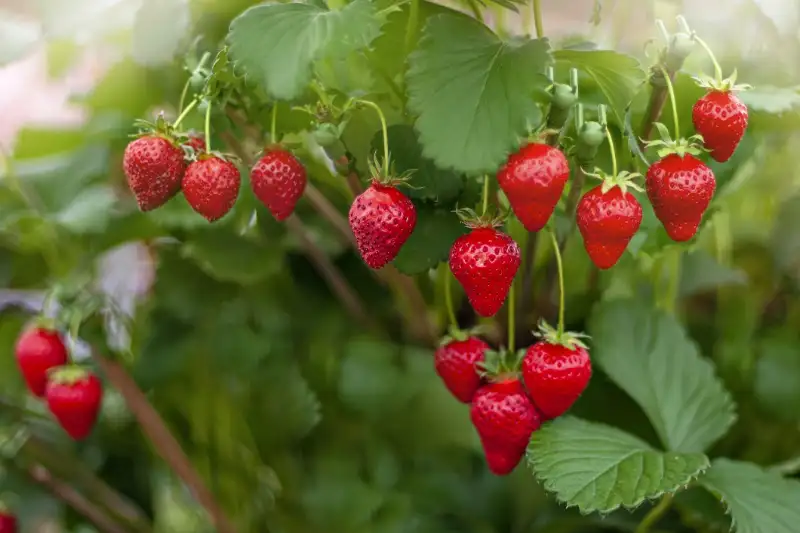Bare-root berries are a POPULAR and BUDGET-EFFECTIVE way to grow strawberries.
Planting bare root strawberries is a SIMPLE process. But it makes many gardeners feel NERVOUS.
If you are also ONE of them, it’s time to put your worries ASIDE. Because HERE we are, the Gardening Experts.
We have SPENT years learning and experiencing about berries and other fruits.
Regarding our experiences, we can HELP you to CLEAR your head.
LISTEN! I ASSURE you that after reading this post, your nervousness goes FAR AWAY.
Learn what’s the best time to plant and harvest bare-root strawberries.

The Basics of Bare Root Strawberries

Bare-root strawberries are strawberry CROWNS with bare roots.
These crowns are DUG UP from the mother plant and SOLD without soil. They APPEAR like shrunk-up roots with some WILTED foliage attached.
This DORMANT PHASE makes strawberries more amenable to storage and shipping. Incredible, isn’t that?
They are often SOLD during the dormant season when the plants are not ACTIVELY growing. And so are LESS EXPENSIVE than potted plants.
But what about purchasing them?
- While purchasing bare-root plants, CHOOSING a healthy plant with plump roots is essential.
- It is also crucial to PREVENT the roots from drying out after PURCHASE. You can plant them directly in the garden beds or a container for this purpose.
- Properly planting beds ENSURES the BEGINNING of the growth of berries shortly.
The Best Time to Plant Bare Root Strawberries

The EXCELLENT TIME to plant bare-root strawberries is in the late winter or the early spring. It typically depends on the climate of the region.
Getting my point? Aren’t you?
Let me tell you the reason.
Planting during this time ALLOWS the plant to ESTABLISH its roots before the warm months. And also gives them the time to DEVELOP strong foliage for the next growing season.
Generally, bare-root strawberries can be planted as early as POSSIBLE after purchase. Doing so HELPS in minimizing plant stress and ENSURES optimal growth.
Isn’t that awesome?
LISTEN! Plant your bare-root strawberry in late winter or early spring.
PROVIDE them with PROPER CARE and protection. IN RETURN, your plant will give you a bountiful harvest of delicious berries.
Steps of Planting Bare Root Strawberries

Planting bare-root strawberries seem like a DAUNTING task.
But with some SIMPLE steps, you can ensure the plant GETS OFF to a good start.
Here is a step-wise guide to planting bare-root strawberries:
1. Choose a Sunny Location
Choose a sunny location and well-drained potting soil for your bare-root strawberry patches.
- Strawberries NEED at least 6 hours of sun daily to grow and produce fruit. So make sure to SELECT a location where they RECEIVE plenty of sunlight.
- Also, ensure that the soil is well drained to keep roots moist and prevent waterlogging.
2. Prepare the Soil
After choosing the RIGHT SPOT, the next step you need to TAKE is to PREPARE the garden’s soil.
- Prepare well-draining soil with PLENTY of compost mixed in it.
- Remove any weeds or debris from the soil.
- Plant your own strawberries in loamy soil at least 12 inches deep for excellent results. It gives the roots enough ROOM to spread and grow into the ground.
3. Trim the Roots
Always trim the roots while planting bare-root strawberries with SHARP scissors.
LISTEN! Trimming HELPS prevent the roots’ overcrowding, thus STIMULATING new leaf growth.
You can cut back only by 1/3 to 1/4 of the roots, but not more than that.
Because if your plant’s roots are LESS than 6-8 inches, you won’t get a DEVELOPED plant. Strange, isn’t that?
4. Soak the Roots
When you’re ready to plant strawberries, SOAK the bare roots in water for half an hour. You can EXTEND this period to an hour, but please don’t SUBMERGE the entire plant.
Clear?
Just POUR some water into a bowl and place the bare root plants into that bowl. It will rehydrate the roots and PREPARE them for planting.
If you aren’t planting for a FEW days, you can store your bare root strawberry plants in the refrigerator.
5. Dig a Hole
Dig a planting hole that is WIDE enough to accommodate the roots. And deep enough to LEVEL the plant’s crown with the soil’s surface.
In short, confirm that the HOLE is large enough for root growth without CROWDING them.
6. Plant the Strawberry
Place the strawberry plant in the hole while SPREADING OUT all the roots evenly. Make sure that the plant’s crown is with the soil LEVEL.
After that, fill the hole with the soil, GENTLY TAMPING it down around the plant.
7. Watering and Mulch
Strawberry plants like to be WELL WATERED. So, water your plant thoroughly to SETTLE the soil around the long roots.
The new strawberry patch often takes time to ESTABLISH, so don’t lose hope. Just continue to water your plant FREQUENTLY.
Occasional watering with the fish emulsion to BOOST the growth is also excellent.
Besides watering, you should also ADD mulch to your strawberry patch. It is because mulching helps to
- Conserve moisture
- Suppress weeds
- Keep the soil cool
How Far Apart Do You Plant Bare Root Strawberries?

While growing strawberries, GIVING PLANTS enough room to raise is crucial.
So PLANT your bare-root strawberry plants about 12 to 18 inches apart. But MAKE SURE that the rows of your new plants are two to three feet apart.
Clear?
These spacings are ESSENTIAL as it ALLOWS the plant to get sufficient sunlight and air.
Want to hear how awesome these things are?
Adequate sunlight and air PROMOTE healthy growth and help to PREVENT diseases.
But if you want the strawberry bed to be FILLED ENTIRELY with runner plants later. Plant all the strawberries closer together, probably 8 to 12 inches apart.
It is also essential to CONSIDER which variety you are going to plant. It is because DIFFERENT VARIETIES require more or less space.
Check the planting instructions to DETERMINE the suitable spacing for your SPECIFIC variety.
Proper spacing ensures you produce a decent harvest of your lovely fruit.
How Do You Care For Bare Root Strawberries?

Caring for bare-root strawberry plants is NECESSARY to ensure healthy growth.
A berry patch doesn’t REQUIRE a lot of care. You JUST NEED to consider a few things while caring for your baby strawberry plants.
These include:
Watering
Watering is critical for strawberry beds. So water the plant DEEPLY and regularly, especially during hot weather conditions.
Consistent moisture ensures plump and juicy berries.
But how can you provide consistent water?
Drip irrigation is TREMENDOUSLY helpful in providing CONSISTENT watering to the young roots.
Mulching
ADDING a LAYER of natural mulch around the plants helps to CONSERVE moisture.
Mulch also PREVENTS the fruit from getting dirty and rotten.
But how does it so?
Simply by preventing the DIRECT CONTACT of fruit with the soil.
Organic mulches are PREFERRED over synthetic ones. Some common organic mulches include:
- Straw
- Leaves
- Pine needles
Pruning
Like the previous processes, pruning is also important to MAINTAIN healthy plants.
- Remove any dead or yellowing leaves and prune the runners that plant PRODUCE.
- Remove the first flowers from the newly planted strawberry plant. It allows the plant to put its energy into growing roots.
Once the strawberries are ESTABLISHED, you must feed your plant with high-quality fertilizer.
Fertilizing
Like other plants, the strawberry plant also REQUIRES fertilization to produce healthy fruit.
Therefore, fertilize the plant with the help of balanced fertilizer only once or twice during the growing season.
Balanced fertilizer?
Use a fertilizer that has a 10-10-10 or 14-14-14 ratio of
- Nitrogen
- Phosphorus
- Potassium
Although the strawberry baby plants require fertilization, you must AVOID overfertilizing your plant.
Overfertilization can LEAD to excessive foliage intact and REDUCE fruit production.
Harvesting and Storing Bare Root Strawberries

Harvesting and storing bare-root strawberries is ESSENTIAL to enjoy healthy and flavorful fruit.
Here are a few simple tips for harvesting and storing bare-root strawberry plants:
Harvesting:
- Initially, WAIT until the berries are FULLY RIPE before harvesting. It is because the berries that aren’t RIPENED completely will not be as sweet or tasty.
- Strawberries ripe 30 days after flowering. So, CHECK your plants every day as berries ripen SWIFTLY.
- Cut the stem above the berries using scissors to AVOID damage. PULL the berries OFF can damage the plant and reduce the upcoming yield.
- Pick berries when they are vibrant, tender, and sweet. Ripe berries will SEPARATE easily with their cap from the stem.
- Harvest the riped berries FREQUENTLY to prevent over-ripening. Since overripening berries attract pests and cause the fruit to rot.
- Avoid ripening wet berries as it promotes mold and spoilage. Wait until the plant has DRIED OFF after rainfall.
After harvesting the strawberries, the NEXT THING to consider is how to store them. Let’s see how?
Storing:
- Store your freshly harvested strawberries in the root cellar to maintain their FRESHNESS. Strawberries start to SPOIL right after they are picked. So it is VITAL to store them as soon as possible.
- Don’t try to wash your strawberries before STORING them. Doing so can cause them to SPOIL more quickly.
- You can say that moisture is the ENEMY of fresh strawberries. So it’s ESSENTIAL to keep them dry.
- Place the berries in a container. Cover them with PLASTIC WRAP to prevent them from drying out. Try to use a large container to HOLD the berries without crushing them.
- For extended storage, freeze the berries. Rinse them for half an hour and remove the stems before PLACING them in cold storage.
- Once the berries are FROZEN, move them to a freezer safe container. Now you can STORE them in the freezer for up to six months.
- In contrast, you can also PRESERVE strawberries by canning them. It is a great way to enjoy flavorful strawberries throughout the year.
FAQs about Planting Bare Root Strawberries
1. How do you overwinter bare root strawberries?
To overwinter bare-root strawberries, follow these steps:
· Cover your plant with a LAYER of mulch and straw to PROTECT your plant from cold winters.
· When the ground FREEZES, you can add a layer of snow over the mulch to PROVIDE INSULATION.
· Remove the mulch GRADUALLY as the weather warms up and new growth appears.
2. How long does it take for bare root strawberries to grow?
Bare-root strawberries usually take 3-4 weeks to SHOW signs of growth.
But DEPENDING on the variety, they can take ANYWHERE between 60 to 90 days to produce berries.
It is crucial to note that growth and fruiting also depend on VARIOUS FACTORS, including:
· Weather conditions
· Soil quality
3. How often do you water strawberry bare roots?
You need to water your bare-root strawberry plantsCONSISTENTLY to help them settle into their new location.
Water the bare roots deeply and thoroughly once or twice a week. But MAKE SURE to keep soil and weather conditions under consideration.
ONCE the plant is ESTABLISHED, it may require LESS FREQUENT watering. Still, it is vital to monitor the soil moisture and water requirements.
4. Will bare root strawberries produce the first year?
Yes! Bare-root strawberries can PRODUCE in their first year. But it depends on SEVERAL factors, such as,
· Variety of strawberry
· Planting location
· Growing conditions
Some varieties are KNOWN to produce in their first year. In contrast, others require some time to ESTABLISH and produce fruit.
Make sure the plant is WELL C
What’s Next
Now you have got so many DETAILS about planting and harvesting bare-root strawberries.
Planting bare-root strawberries SEEMS to be a CHALLENGING task. But it becomes EASY if you follow some simple steps.
After planting the strawberries, it is crucial to take PROPER CARE to get a PLENTIFUL harvest.
If you want to LEARN more about berries or other fruit/veggies, VISIT AsterGardening.
Here you will get all the techniques regarding gardening, so if you have any ROADBLOCK reach out to us.
